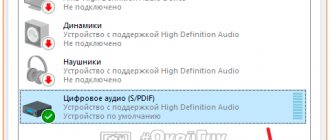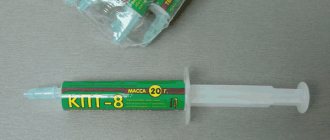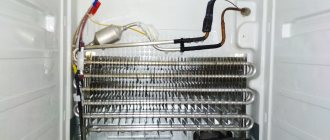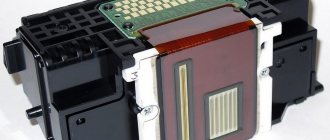First - reboot
If the sound in your laptop suddenly disappears when you launch an application, you need to try to completely reboot the system.
Advice! It is recommended to only save your working data without closing any programs.
If the sound suddenly stops working, you need to:
- click Start-Shutdown;
- select Reboot;
- When prompted to force shutdown applications, confirm your choice.
By performing actions in this way, you can prevent the settings that were initialized by the muted application from being applied. An audio greeting will indicate that the problem has been resolved when the system boots.
Testing playback devices
Right-click on the sound icon again and go to sound settings.
Scroll down and click on “Device and application volume settings.”
Here we are interested in which device the sound is played (output) through. Choose the right one. In our case, there is only one thing – built-in Realtek speakers.
If the output device is installed correctly, but the sound in the laptop still does not work, we will need the “Sound Control Panel”. We go back and go to the specified section.
In the pop-up window, the first section “Playback” is important to us, in which all sound devices are displayed. In our case, there is only one thing - standard built-in speakers. There are several. If the sound stops working, it may be going to the wrong device.
Incorrect device selection by the system is one of the possible reasons why the sound does not work after headphones or external speakers. After turning off the device, it is possible that the system does not automatically switch to internal speakers.
Let's check our built-in. Right-click and select “Set up speakers.”
Click on the green triangle “Check”. The sound should be played alternately from the left and right speakers. If there is no playback, we will solve the problem further.
Then click “Next”. We will be offered a choice of full-range speakers, but you can skip this section. Click “Next” again, and then click “Finish”.
Accidental button presses
The laptop is quite compact. Keyboard buttons are often pressed accidentally. Therefore, to restore sound on a laptop, you should first try the desired functional combination.
Advice! You can find out exactly what you need to press from the instructions for your model.
But you can find the necessary buttons when the sound suddenly disappears without studying the documentation. It's worth taking a closer look at the keyboard. The key, in addition to the main symbol that shows a crossed out speaker, when pressed simultaneously with Fn, mutes the sound . Using this combination, it is easy to fix the situation when your favorite track or movie does not play.
Likewise, if there is no sound, you can try increasing the volume. This is also done using functional keyboard combinations. The required buttons are indicated by symbols with a speaker, plus and minus. Their location may differ on different laptop models. For example, on HP and Acer products, the volume is changed using the Fn + arrow keys.
Software volume mute
If there is no sound on your laptop, you should look at the speaker icon in the taskbar next to the clock. If it is crossed out, it means that audio output is software disabled. You can adjust the settings and return the sound as follows:
- in Windows 7, Windows 8, left-click (LMB) on the icon in the taskbar, and in the slider that opens, move the slider to maximum;
- in Windows 10, the procedure is similar, the regulator is a horizontal strip, the slider should be moved to the right.
The reason why there is no sound on the laptop may be software output muting for individual applications or the system. To get to the necessary settings, you should right-click (RMB) on the speaker icon near the clock. In Windows 7, Windows 10, in the drop-down menu there is an item Open volume mixer. The mixer window lists all applications that are currently accessing the audio card. By changing the positions of the sliders, you can solve the problem when there is no sound only when the video or audio player is running.
Change your audio device.
It's possible your speakers are working fine, but Windows is routing audio to the wrong output device - this is especially common if you've connected a USB audio device or are connected to an external HDMI monitor that doesn't have speakers.
See also: Xiaomi presents the self-cleaning robot vacuum cleaner Lydsto R1
To fix this, right-click the speaker icon on the Windows taskbar and select Sounds to enter the sound settings.
In the Playback tab, find the device you want to use - if you don't see it, try right-clicking and checking the Show disabled devices box, then select the output device and click the Set as default button. If you're not sure which one you want to use, try each of the devices on the list until you hear sound.
Invalid playback device
Sound may not work when the system is using the wrong playback device. This problem is present on models with an HDMI output or complex audio cards . If the sound does not turn on, you should:
- right-click on the speaker icon in Windows 7, Windows 10;
- select the Playback devices section from the drop-down menu.
In a laptop, sound is output only through the built-in speakers. This device is called Speakers/Headphones. In the window that opens after selecting Playback devices, you need to check:
- whether the speakers are turned off, whether there is a cross on the device icon;
- whether the output is carried out to the speakers, whether there is a green tick icon on it.
The level indicator next to the device name indicates that everything is in order. If there is no sound, it will be grayed out.
Advice! An easy way to determine the cause of the problem and restore the operation of the speakers is to use the system wizard. It detects most incorrect settings and suggests changing them automatically.
If the sound does not turn on, it is enough:
- disconnect any speakers or headphones from the laptop;
- right-click on the speaker icon;
- Click on Troubleshoot from the drop-down menu.
All that is required from the user is to wait for the wizard to finish. When there is no sound on the laptop due to changes in system settings, the troubleshooter will detect and fix them on its own.
Incorrect Windows mixer settings
If there is no sound only in a separate application (browser, player, game), check the settings of the program itself. You may have accidentally pressed the music mute button or used a keyboard shortcut that causes it to mute. If everything is fine in the application settings, the audio may be muted in the Windows volume mixer.
To open the mixer, right-click on the speaker icon in the tray and select the first item in the context menu. The program in which the sound has disappeared must be open at this moment in order for it to appear in the list. The mixer allows you to adjust the volume level for each application using individual sliders. Check that the sound is on (the speaker icon is not crossed out) and set the required level.
Driver problems
Unfortunately, problems with sound card drivers may not be the user's fault. This happens when updating the system or installing various software. To assess the status of the drivers, you will need:
- go to Start-Control Panel-System, click the Device Manager button on the active tab;
- right-click on Computer, select management, section Manager in the left column;
- Press Win+R and type the command devmgmt.msc.
Using any of these methods, you can call up a list of devices installed in the system. Audio drivers are located in the Audio Devices section. If there is a problem, the block will be deployed immediately. When the name of the audio device has an icon with a red cross, you should right-click on it and select Enable.
A yellow triangle icon means that the drivers are not working correctly. First of all, you should try to roll back the installation and return to a working version. To do this, you need:
- click on the name of the device RMB;
- select Properties from the menu;
- go to the Driver tab.
There is a Rollback button here. After clicking it, the system will try to remove the latest installed driver version. The laptop should be restarted.
Updating the driver package
If there is no sound on the laptop, and rolling back the driver version does not help, you need to update all software sound modules. To do this you will need:
- download a full set of drivers from the laptop manufacturer’s website;
- remove all audio devices from the system using the task manager;
- install downloaded drivers;
- reboot the laptop.
If the audio card is not physically damaged, which happens due to static shock on Lenovo models, drivers from the manufacturer will certainly allow you to restore sound on the laptop.
Install or update drivers.
If you doubt that some laptop hardware is not working, check the drivers. Click the Start menu and type "device manager" and press Enter when the option appears.
Scroll down to Sound, Video and Game Controllers and expand the menu to show all the possible audio output devices on your PC.
If any of them have a yellow exclamation mark next to them, that means you may have to find and install a driver from the manufacturer's website.
See also New printing process turns plain paper into interactive paper
If not, then you should try installing the driver anyway. You can also try uninstalling the driver: right-click the one you're trying to use (in this case, the laptop uses Realtek Audio) and select "Uninstall device." Restart Windows and it will try to reinstall its general drivers, which may bring the speakers back to life.
BIOS settings
Every laptop has BIOS settings stored on a chip powered by a battery. The latter does not last forever, and after many years of use it may turn out that there is no sound on the laptop when you turn it on. This means you need to check the BIOS.
Enabling and disabling the sound card on laptops can be done in different sections. For ASUS products this is Advanced, in some Lenovo, HP - Integrated Peripherals. The audio card itself may be called High Definition Audio, Onboard Audio Chip, or a line with the manufacturer's name ending in Codec (for example, Azalia Codec). The option value must be set to Enabled to restore sound on the laptop.
Connector problems
The 3.5 mm mini-jack for headphones, which is found in almost all laptops, has a service contact. It signals the audio card to turn off the speakers to play audio only to the headphones. Over time, the service contact may become deformed and constantly transmit data to the system that the headphones are connected.
The problem doesn't come out of the blue. The sound begins to disappear when the plug is moved, plays unevenly in the headphones, and is present in only one loudspeaker. If this situation develops, the speakers may turn off precisely because of a connector problem. As a result, the sound does not work in any application.
Advice! If you do not have enough skills to clean and repair the nest yourself, you should contact the service.











